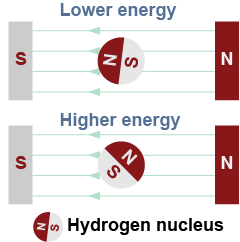|
Waves and resonance are found throughout human technology. One specific area in which wave technology has had a profound impact is in medicine. A hundred years ago doctors had no way to sense directly what went on inside the body except to cut and look. Of course “cutting and looking” is painful, dangerous, and may cause more harm than help. 
|
Today if you fall hard on your hand you get an x-ray, like the one in the picture. Can you see where a bone has fractured? X-rays revolutionized the treatment of injuries because a doctor could know whether a bone was broken, where the break was, and how serious it was. 
| 
|
X-rays work on the principle of absorption. The element calcium is a strong absorber of x-rays. Skin and muscle tissue are only weak absorbers of x-rays. When the x-rays went through the hand in the picture, they exposed and darkened the film directly behind any skin or muscle. Where there was bone, however, the x-ray energy was absorbed and therefore the film is less exposed. 
|
Magnetic resonance imaging scanners work on the resonant absorption of radio-frequency waves by hydrogen atoms. Hydrogen is in water molecules so it is found throughout the body, giving MRI the advantage of “seeing” different kinds of soft tissues. X-rays essentially see only calcium, which is dense only in bones. High-energy X-rays can also damage living cells, so doctors usually try to limit a patient’s exposure. 
|
 MRI makes detailed images of internal organs with no harm to the body. To make an MRI scan the patient is placed inside a very precise electromagnet. The nuclei of hydrogen atoms act like tiny magnets. When the magnetic poles of the hydrogen nucleus are aligned with the MRI magnetic field the atom has slightly less energy than when the poles are not aligned. This energy difference is very sensitive to the exact strength of the magnetic field.
MRI makes detailed images of internal organs with no harm to the body. To make an MRI scan the patient is placed inside a very precise electromagnet. The nuclei of hydrogen atoms act like tiny magnets. When the magnetic poles of the hydrogen nucleus are aligned with the MRI magnetic field the atom has slightly less energy than when the poles are not aligned. This energy difference is very sensitive to the exact strength of the magnetic field. 
|
Hydrogen nuclei do not statically align to the MRI field but rather oscillate around the field with a particular frequency. If a radio wave has a frequency that is resonant with the oscillation of the hydrogen nuclei, it causes the nuclei to flip. The flip releases characteristic energy that is detected and used to create the image. By tuning the radio wave precisely, MRI technology can reveal whether the hydrogen is in fatty tissue, water, or other tissue types. 
|
Laser metrology is an application of light waves to measure distances with high precision. One method uses pulses of laser light and times how long it takes for each pulse to be reflected off a mirror and return to the instrument. This has been used to measure the distance to the Moon by reflecting laser light off mirrors installed on the Moon by the Apollo astronauts. Another method uses the interference between laser light and its reflection off the surface of an object. This method can be used in laser versions of coordinate measuring machines to measure the surface dimensions of manufactured parts. 
|

